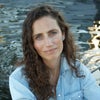The dancers are crossing and intermingling, swirling together on the stage. They’re trying to move like an estuary. After this rehearsal, in early August,��they��performed this piece in ,��a multimedia dance concert in Grand Junction, Colorado, about the town’s namesake confluence.��
The Gunnison and Colorado Rivers converge in town, and artistic and visionary director Rebecca Fleishman wanted to show the confluence’s��many facets, and why it’s so crucial to the community, through dance. She’s been running rivers for 15 years and even met her husband in a river-safety class.��“It’s ephemeral, it’s about being in the moment,” she says. “And dance is ephemeral, too. River is all about movement. So is dance. Dance is underfunded—dancers get hardly paid and it’s underappreciated—and rivers are, too. When I started thinking about it, there was parallel after parallel.”
Fleishman, whose most recent show was about different aspects of nighttime, started brainstorming about combining the concept of rivers and dance two years ago. Last year, when the western slope of Colorado was suffering from��drought, she reached out to local nonprofit about a dance performance that would follow��the life of the river��and could fundraise for work on the river. “They don’t know anything about dance, but I came at them with all this enthusiasm,” she says. When the group��got behind the idea, she had a twofold challenge: First, how would she tell a story about conservation and currents with movement? And how would she do it in a way that wouldn’t weird out the paddlers��or feel preachy to the arts community?
Translating concepts like endangered fish and confluences to choreography is tricky, especially when your dancers and your audience aren’t necessarily water people. “It’s a head trip,” Fleishman says. “No one in the cast knew how a river formed��or what an estuary was, so we studied videos about them and had the dancers bring homework.” She says the performers now have a new relationship with rivers, both in terms of what they know about the ecosystem��and how they move. “If you think about your veins moving like a river, you can move like them,” one dancer says in a video piece that’s part of the performance.��
The first piece of the performance, called��“Eddy,” emphasized the back-and-forth between two dancers to show how obstacles in the river change and redirect flows. “We studied what eddies do and what they mean. It can be getting out of danger, and it can be dangerous,” Fleishman says. In another piece, called��“Wave Train,” a group of dancers made��currents with their bodies. “We thought about river currents, which feel like they’re so metaphorically about our feelings. We wanted chaos, because wave trains have that, and I wanted to capture those dynamics.”��
While dance was��the backbone of the event,��there was also poetry, music, and a video of some of the performers dancing on the banks of the Colorado, soaked in evening light. They wore��dresses over wet bathing suits—what you’d wear on a river trip—to ground the experience in what’s going on in the outside world.��
Fleischman says that was part of the goal for the performance. She wanted to set the dynamics of the river into a different kind of motion, but she also wanted to show the threats to the drought-stricken, overused, often ignored waterway so that it would resonate differently than a didactic lecture or press release.
“I want to bring together different demographics, like the arts community, conservationists, and fishermen,” she says. “It’s been challenging to try to roll this out in a way��that it’s intriguing��but not alienating. I don’t want to be too arty for people who are uncomfortable with arts.” She also tried��to show why it’s important to be on or near water��and what it can do for mental health and connection. “I want someone to feel something. That’s what dance does for me—it’s not just motion for motion’s sake. Instead of reading��or seeing a beautiful painting, I wanted them to feel something ephemeral. I hope it sparks something.”


